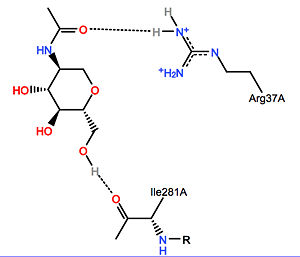Galactosylceramidase
From Proteopedia
| Line 37: | Line 37: | ||
== Disease == | == Disease == | ||
| - | Defects in this enzyme cause a lysosomal storage disorder known in humans as Krabbe disease (or globoid cell leukodystrophy). Krabbe disease is a neurodegenerative disorder characterized by widespread demyelination caused by reduced or mutated function of GALC<ref name=Deane>PMID: 21876145</ref>. The deficiency of GALC leads to the accumulation of the neurotoxic metabolite 1-β-d-galactosylsphingosine (psychosine) in the central nervous system. Psychosine causes the destruction of epithelial actin structures and is toxic to oligodendrocytes<ref name=Belleri>PMID: 23983033</ref><ref name=Kohlschutter>PMID: 23622382</ref>. GALC deficiency also causes the accumulation of lipids in "globoid" macrophages, where the medical name for the disease originated<ref name=Kohlschutter>PMID: 23622382</ref>. A common authentic model for this disease is the twitcher mouse model<ref name=Belleri>PMID: 23983033</ref>. The only treatment currently available is an experiemental hematopoietic stem cell transplant, and gene therapies and enzyme replacements are still being researched<ref name=Kohlschutter>PMID: 23622382 </ref>. | + | Defects in this enzyme cause a lysosomal storage disorder known in humans as Krabbe disease (or globoid cell leukodystrophy). Krabbe disease is a neurodegenerative disorder characterized by widespread demyelination caused by reduced or mutated function of GALC<ref name=Deane>PMID: 21876145</ref>. The deficiency of GALC leads to the accumulation of the neurotoxic metabolite 1-β-d-galactosylsphingosine (psychosine) in the central nervous system. Psychosine causes the destruction of epithelial actin structures and is toxic to oligodendrocytes<ref name=Belleri>PMID: 23983033</ref><ref name=Kohlschutter>PMID: 23622382</ref<, by causing lipid raft clustering which leads to defective signal transduction<ref name=Teixeira>PMID: 24607884</ref>. Besides the defective recruitment of signal molecules to lipid rafts, there is also impairment in the early steps of endocytosis and vesicle transport<ref name=Teixeira>PMID: 24607884</ref>. Defects in the retrograde axonal transport is correlated with decreased amounts of dynein, unusual levels of post-translational tubulin modifications, and microtubule instability<ref name=Teixeira>PMID: 24607884</ref>. GALC deficiency also causes the accumulation of lipids in "globoid" macrophages, where the medical name for the disease originated<ref name=Kohlschutter>PMID: 23622382</ref>. A common authentic model for this disease is the twitcher mouse model<ref name=Belleri>PMID: 23983033</ref>. The only treatment currently available is an experiemental hematopoietic stem cell transplant, and gene therapies and enzyme replacements are still being researched<ref name=Kohlschutter>PMID: 23622382 </ref>. |
== Relevance == | == Relevance == | ||
Revision as of 17:17, 4 June 2014
| |||||||||||
Krabbe disease is a devastating neurodegenerative disease characterized by widespread demyelination that is caused by defects in the enzyme galactocerebrosidase (GALC). Disease-causing mutations have been identified throughout the GALC gene. However, a molecular understanding of the effect of these mutations has been hampered by the lack of structural data for this enzyme. Here we present the crystal structures of GALC and the GALC-product complex, revealing a novel domain architecture with a previously uncharacterized lectin domain not observed in other hydrolases. All three domains of GALC contribute residues to the substrate-binding pocket, and disease-causing mutations are widely distributed throughout the protein. Our structures provide an essential insight into the diverse effects of pathogenic mutations on GALC function in human Krabbe variants and a compelling explanation for the severity of many mutations associated with fatal infantile disease. The localization of disease-associated mutations in the structure of GALC will facilitate identification of those patients that would be responsive to pharmacological chaperone therapies. Furthermore, our structure provides the atomic framework for the design of such drugs.
Insights into Krabbe disease from structures of galactocerebrosidase., Deane JE, Graham SC, Kim NN, Stein PE, McNair R, Cachon-Gonzalez MB, Cox TM, Read RJ, Proc Natl Acad Sci U S A. 2011 Sep 13;108(37):15169-73. Epub 2011 Aug 29. PMID:21876145
From MEDLINE®/PubMed®, a database of the U.S. National Library of Medicine.
Ligands
- calcium ion
- N-acetyl-D-glucosamine
Inhibitors
Inhibitory molecules in humans include:
- 6-hexadecanoylamino-4-methylbelliferyl-beta-D-galactopyranoside, competitive inhibition
- D-galactose
- galactonyl hydrazide
- lactose
- N-(6-aminohexyl)-D-galactoside
- taurocholate (at high concentrations above 0.3% w/v)[8]
References
- ↑ RCSB Protein Data Bank - RCSB PDB - 3ZR5 Structure Summary. (n.d.). RCSB Protein Data Bank - RCSB PDB - 3ZR5 Structure Summary. Retrieved June 3, 2014, from www.rcsb.org DOI:10.2210/pdb3zr5/pdb
- ↑ Zizioli D, Guarienti M, Tobia C, Gariano G, Borsani G, Bresciani R, Ronca R, Giacopuzzi E, Preti A, Gaudenzi G, Belleri M, Di Salle E, Fabrias G, Casas J, Ribatti D, Monti E, Presta M. Molecular cloning and knockdown of galactocerebrosidase in zebrafish: new insights into the pathogenesis of Krabbe's disease. Biochim Biophys Acta. 2014 Apr;1842(4):665-75. doi: 10.1016/j.bbadis.2014.01.008., Epub 2014 Jan 24. PMID:24463171 doi:http://dx.doi.org/10.1016/j.bbadis.2014.01.008
- ↑ 3.0 3.1 Deane JE, Graham SC, Kim NN, Stein PE, McNair R, Cachon-Gonzalez MB, Cox TM, Read RJ. Insights into Krabbe disease from structures of galactocerebrosidase. Proc Natl Acad Sci U S A. 2011 Sep 13;108(37):15169-73. Epub 2011 Aug 29. PMID:21876145 doi:10.1073/pnas.1105639108
- ↑ Visigalli I, Ungari S, Martino S, Park H, Cesani M, Gentner B, Sergi Sergi L, Orlacchio A, Naldini L, Biffi A. The galactocerebrosidase enzyme contributes to the maintenance of a functional hematopoietic stem cell niche. Blood. 2010 Sep 16;116(11):1857-66. doi: 10.1182/blood-2009-12-256461. Epub 2010 , May 28. PMID:20511539 doi:http://dx.doi.org/10.1182/blood-2009-12-256461
- ↑ 5.0 5.1 Belleri M, Ronca R, Coltrini D, Nico B, Ribatti D, Poliani PL, Giacomini A, Alessi P, Marchesini S, Santos MB, Bongarzone ER, Presta M. Inhibition of angiogenesis by beta-galactosylceramidase deficiency in globoid cell leukodystrophy. Brain. 2013 Sep;136(Pt 9):2859-75. doi: 10.1093/brain/awt215. PMID:23983033 doi:http://dx.doi.org/10.1093/brain/awt215
- ↑ 6.0 6.1 6.2 PMID: 23622382</ref<, by causing lipid raft clustering which leads to defective signal transduction<ref>PMID: 24607884</li> <li id="cite_note-Teixeira-6">↑ <sup>[[#cite_ref-Teixeira_6-0|7.0]]</sup> <sup>[[#cite_ref-Teixeira_6-1|7.1]]</sup> Teixeira CA, Miranda CO, Sousa VF, Santos TE, Malheiro AR, Solomon M, Maegawa GH, Brites P, Sousa MM. Early axonal loss accompanied by impaired endocytosis, abnormal axonal transport, and decreased microtubule stability occur in the model of Krabbe's disease. Neurobiol Dis. 2014 Jun;66:92-103. doi: 10.1016/j.nbd.2014.02.012. Epub 2014 Mar , 6. PMID:[http://www.ncbi.nlm.nih.gov/pubmed/24607884 24607884] doi:[http://dx.doi.org/10.1016/j.nbd.2014.02.012 http://dx.doi.org/10.1016/j.nbd.2014.02.012]</li> <li id="cite_note-BRENDA-7">[[#cite_ref-BRENDA_7-0|↑]] EC 3.2.1.46 - galactosylceramidase. (n.d.). Information on. Retrieved June 3, 2014, from www.brenda-enzymes.org</li></ol></ref>
Proteopedia Page Contributors and Editors (what is this?)
Alison Stivers, Michal Harel, Dillon Shapiro, Angel Herraez, Joel L. Sussman


